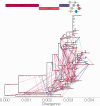MERS-CoV recombination: implications about the reservoir and potential for adaptation
- PMID: 27774293
- PMCID: PMC4989901
- DOI: 10.1093/ve/vev023
MERS-CoV recombination: implications about the reservoir and potential for adaptation
Abstract
Recombination is a process that unlinks neighboring loci allowing for independent evolutionary trajectories within genomes of many organisms. If not properly accounted for, recombination can compromise many evolutionary analyses. In addition, when dealing with organisms that are not obligately sexually reproducing, recombination gives insight into the rate at which distinct genetic lineages come into contact. Since June 2012, Middle East respiratory syndrome coronavirus (MERS-CoV) has caused 1,106 laboratory-confirmed infections, with 421 MERS-CoV-associated deaths as of 16 April 2015. Although bats are considered as the likely ultimate source of zoonotic betacoronaviruses, dromedary camels have been consistently implicated as the source of current human infections in the Middle East. In this article, we use phylogenetic methods and simulations to show that MERS-CoV genome has likely undergone numerous recombinations recently. Recombination in MERS-CoV implies frequent co-infection with distinct lineages of MERS-CoV, probably in camels given the current understanding of MERS-CoV epidemiology.
Keywords: MERS; MERS-CoV; co-infection; coronavirus; homoplasy; recombination.
Figures






Similar articles
-
Middle East respiratory syndrome coronavirus (MERS-CoV): animal to human interaction.Pathog Glob Health. 2015;109(8):354-62. doi: 10.1080/20477724.2015.1122852. Pathog Glob Health. 2015. PMID: 26924345 Free PMC article. Review.
-
Cross-sectional study of MERS-CoV-specific RNA and antibodies in animals that have had contact with MERS patients in Saudi Arabia.J Infect Public Health. 2018 May-Jun;11(3):331-338. doi: 10.1016/j.jiph.2017.09.022. Epub 2017 Oct 6. J Infect Public Health. 2018. PMID: 28993171 Free PMC article.
-
Absence of MERS-CoV antibodies in feral camels in Australia: Implications for the pathogen's origin and spread.One Health. 2015 Nov 2;1:76-82. doi: 10.1016/j.onehlt.2015.10.003. eCollection 2015 Dec. One Health. 2015. PMID: 28616468 Free PMC article.
-
Further Evidence for Bats as the Evolutionary Source of Middle East Respiratory Syndrome Coronavirus.mBio. 2017 Apr 4;8(2):e00373-17. doi: 10.1128/mBio.00373-17. mBio. 2017. PMID: 28377531 Free PMC article.
-
Global status of Middle East respiratory syndrome coronavirus in dromedary camels: a systematic review.Epidemiol Infect. 2019 Jan;147:e84. doi: 10.1017/S095026881800345X. Epidemiol Infect. 2019. PMID: 30869000 Free PMC article.
Cited by
-
Evolving sequence mutations in the Middle East Respiratory Syndrome Coronavirus (MERS-CoV).J Infect Public Health. 2020 Oct;13(10):1544-1550. doi: 10.1016/j.jiph.2020.06.030. Epub 2020 Jul 1. J Infect Public Health. 2020. PMID: 32654959 Free PMC article.
-
Recombination in Positive-Strand RNA Viruses.Front Microbiol. 2022 May 18;13:870759. doi: 10.3389/fmicb.2022.870759. eCollection 2022. Front Microbiol. 2022. PMID: 35663855 Free PMC article. Review.
-
Animal models for the risk assessment of viral pandemic potential.Lab Anim Res. 2020 Apr 22;36:11. doi: 10.1186/s42826-020-00040-6. eCollection 2020. Lab Anim Res. 2020. PMID: 32337177 Free PMC article. Review.
-
Natural selection in the evolution of SARS-CoV-2 in bats created a generalist virus and highly capable human pathogen.PLoS Biol. 2021 Mar 12;19(3):e3001115. doi: 10.1371/journal.pbio.3001115. eCollection 2021 Mar. PLoS Biol. 2021. PMID: 33711012 Free PMC article.
-
Evolutionary trajectory of SARS-CoV-2 and emerging variants.Virol J. 2021 Aug 13;18(1):166. doi: 10.1186/s12985-021-01633-w. Virol J. 2021. PMID: 34389034 Free PMC article. Review.
References
LinkOut - more resources
Full Text Sources
Other Literature Sources
Miscellaneous

